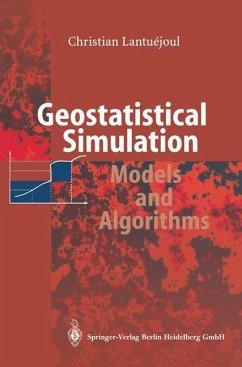1. 1 Simulation versus estimation The following problem was raised by Alfaro (1979). A submarine cable has to be laid across the straits of Gibraltar. How can its length be predicted if the depth of the sea floor has been measured sparsely along its trajectory? Fig. 1. 1. Part of the actual trajectory and sample data points An exact determination of the length requires knowledge of the depth at each point of the trajectory. But these are mostly unknown. In a geostatistical set ting, they are considered as random and can be estimated by linear regression starting from the available data points. This suggests estimating the actual length as the length of the estimated trajectory. The results turn out to be disappointing. The length of the trajectory is seriously underestimated (see Figure 1. 2). Clearly, the estimated trajectory is much smoother than the actual one. Fig. 1. 2. Part of the actual trajectory and its estimate from linear regression. In this particular example, the estimated trajectory is piecewise linear because the linear regression has been carried out using an exponential covariance function 2 1. Introduction What is really questionable in this procedure is not the construction of an estimator for the length starting from the depth estimator, but the depth estimator itself. Linear regression estimation requires only the mean and the covariance function. But the covariance function does not tell us much about the length of the trajectories. Figure 1.
From the reviews of the first edition: "Geostatistical simulations have mainly been developed during the last decade. ... this is the first book that is entirely dedicated to this subject. ... it has been a good initiative by C. Lantuéjoul to compile this book and it will become a basic reference work, partly because it is the first work dedicated entirely to this new subject of geostatistics. ... The book mainly aims at researchers who are using geostatistical simulations and who would like to know more about the theoretical background ... ." (André Vervoort, Geologica Belgica, Vol. 7 (3-4), 2004) "The author has dedicated the book to Georges Matheron, founder of modern geostatistics. Well organized is the book in three parts, namely (i) the tools, (ii) the algorithm and (iii) the models. ... It certainly fills a gap and is therefore welcome to the geostatistics market." (Erik W. Grafarend, Zentralblatt MATH, Vol. 990 (15), 2002)








